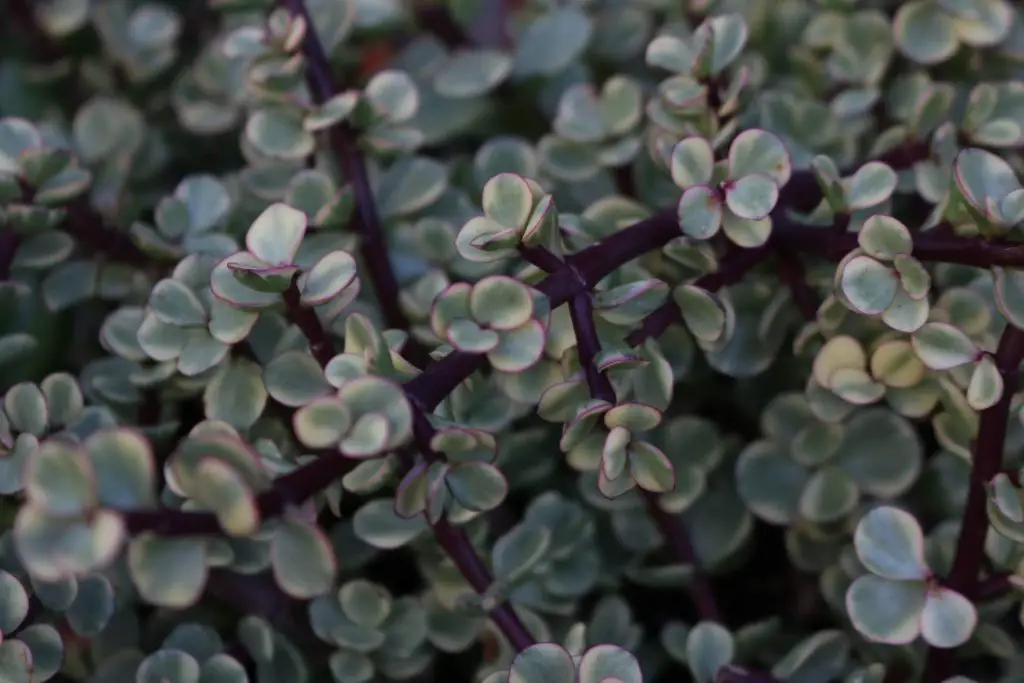Elephant bush also is known as elephant food, dwarf jade, and Portulacaria Afra. The right watering practice for the Elephant bush is easy. Because of its ability to relatively tolerate underwatering and overwatering.
In this article, I will discuss the best practices for watering elephant bush. Plus, I will tell you the factors that determine how often you should water your dwarf jade.
And the right water type to use. Also, we gonna discuss how you should water your elephant bush in case it planted in a planter without drainage holes.
But before diving deep into the details I will put the answer for our main question as simple as this: how to water elephant bush? Elephant bush should be watered during fall and spring more frequently than in summer because it is a winter grower. In fall and spring water elephant bush whenever the soil is completely dry. And when you water it water until the water drains from the drainage holes.
Keep reading to know the factors that affect how often you should water your elephant bush.

Factors affecting Elephant bush watering schedule
Season
The elephant bush is a winter grower. This means it is actively growing during spring and fall. Therefore, it will consume more water in a such season in order to support its new growth.
While in summer elephant bush tends to go dormant especially the ones that located outdoor. For such elephant bush reduce the watering frequency in summer.
Because the plant in such a season focuses on rest rather than growth. It will consume less water. And if you over watered in summer it will be vulnerable to root rot.
Pot size
Bigger pots retain more moisture when compared with the smaller ones. Make sure to use a pot that fits your plant size.
The right pot for elephant ears has a length of 1/3 of the plant length and has a reasonable diameter. If the planter is bigger the watering should be less frequently and vice versa.
Indoor or outdoor
The indoor elephant bush consumes less water when compared with the outdoor ones. Because of the evaporation rate and the airflow is higher outdoor. Therefore water your indoor elephant bush less frequently.
Elephant Bush variety
The standard elephant bush consumes less water than the variegated varieties.
That being said, let’s discuss how exactly you should water your elephant bush.
The right way to water elephant bush
During the growing season ( spring and fall) water your plant only when the soil is completely dry. You can know whether the soil is completely dry or not by inserting a stick through the drainage holes ( from the bottom).
If the stick comes out completely dry. Then you water your elephant bush otherwise don’t. And when you water it do it deeply. Deep watering is pouring water until the water comes out from the drainage holes.
This method of watering called the soak and dry method. It is a famous method among succulent growers.
By following this method you mimicking the elephant bush natural habitat. The elephant bush is succulent.
That means it retains water in its leaves and stem. Therefore it needs drought time in order to use the stored water without being stressed with extra moisture.
Also, make sure to pour the water gently and distribute the watering among all the planter sides. If you just poured the water in one spot you make some roots exposed.
And when some spots in the soil not getting enough moisture the leaves that on the same side may develop underwatering signs. This is because the roots in the dry side supposed to feed the dried leaves.
During summer outdoor elephant bush will go dormant. Therefore only water them when their leaves start to look limp and dull. Don’t worry elephant bush is a very forgiving plant it will tolerate little drought.
Although it will tolerate little overwatering. In summer don’t follow the soak and dry method as you do in fall and spring. But remember growing season and dormancy is not just about the timing it is about the environmental conditions.
Indoor elephant bushes rarely go dormant during summer. Because most indoor environments are moderate throughout the year. Due to the air conditioner.
Therefore treat your indoor elephant bush as it is in the growing season throughout the year in terms of watering. Follow the soak and dry method for indoor elephant bush year-round.
Now you know how to water your elephant bush. But there are two things that are even more important than your watering habits.
First, the soil you use for your dwarf jade. Only plant your elephant bush in cactus and succulent potting mix. Such a mix allows airflow in the roots zone. It also allows excess water to drains quickly.
Second, make sure to use a pot with plenty of drainage holes. I can’t explain enough how this is important for your plant health. I don’t recommend potting your elephant bush in a container without drainage holes.
however, in the next section, I will discuss how to have the best success odds when watering an elephant bush planted in a planter without drainage holes.
Watering Elephant bush in planter without drainage holes
Some people may insist to use a planter without drainage holes for different reasons. In such a case the most important factor for your elephant bush survival is the watering practice.
The equation for successful drainage holes free watering is to give the plant enough moisture and at the same time there is no extra water setting in the soil for a long period of time.
Accomplishing such an equation is not easy. From trial and error, I found that the amount of water that comes near to such an equation equals half of the soil volume.
For example, if the soil fills X container. You should water your elephant bush water that equals half of the X container. And only you do so when the soil is completely dry.
There is another method. You can carry the plant container regularly and feeling its weight. When the container weight is not getting lighter anymore. It means the soil is completely dry. Then you can water.
Following this method require practice, but through time you will know when you should water your plant just from the planter weight.
Signs of underwatered elephant bush
Underwatered elephant bush tends to have limp and dull leaves. If you notice such signs in your plant don’t worry. Just follow the soak and dry method if it is located indoors.
And if it is located outdoor use such signs as watering notifiers during the summer. This means only water the plant when it shows such signs.
If your plant is located outdoors and the season is spring or fall follow the soak and dry method.
Signs of overwatered elephant bush
Overwatereted elephant bush will have a mushy stem. And yellowing or transparent leaves. In such a case cut back the watering frequency until your plant recover.
Overwatering is very dangerous to most plants. But the elephant bush is really forgiving for both underwatering and overwatering.
The right water type for elephant bush
Rainwater is the best option you can give to your elephant bush. You can collect rainwater during the fall season. Then use it throughout the year.
The second-best option if you currently don’t have rainwater is distilled water. Purified water is also ok.
But avoid using tap water because tap water contains treated chemicals that will build up in the soil through time as salts.
Those salts and minerals will make essential nutrients unavailable for the roots to absorb. In case you only have access to tap water. Make sure to treat it before using it.
You do so by letting the water set in an open container overnight for some treated chemicals to dissipate in the air.
Can I mist my elephant bush?
Elephant bush doesn’t need misting either it is indoor or outdoor. You can mist outdoor ones if you like misting. But the plant doesn’t need it. Only mist during the morning in order for the water to evaporate.
Misting indoor elephant bush can do more harm than good. But the indoor environment will allow the misted water to set in the leaves for a long period of time without evaporating. And such a thing may cause rot.
In conclusion
When it comes to watering elephant ears follow the soak and dry method for indoor ones throughout the year.
For outdoor elephant bush, in summer water it deeply only when it shows signs of dehydration ( limp and dull leaves). While in fall and spring follow the soak and dry method for outdoor elephant bush. For more detailed information and a holistic perspective on caring for potted plants and mastering Container Gardening, Get my book Container Gardening: A Step-by-Step Practical Guide.
